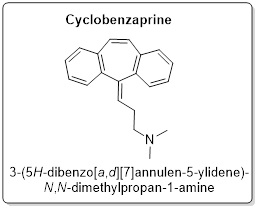Cyclobenzaprine

Cyclobenzaprine is structurally similar to tricyclic antidepressants like amitriptyline and cyproheptadine. It is a centrally acting skeletal muscle relaxant which relieves skeletal muscle spasms of local origin without interfering with muscle function. Cyclobenzaprine is FDA approved as an adjunct to rest for the treatment of muscle spasms associated with acute, painful musculoskeletal conditions. It's exact mechanism is 5-HT2 receptor antagonist which is responsible for the antispasmodic effect, due to inhibition of serotonergic, not noradrenergic, descending systems in the spinal cord. Synthesis Structurally similar drugs with MOA Other marketed muscle relaxants Reference NIH National library of medicine WO 2012/098563/A2

